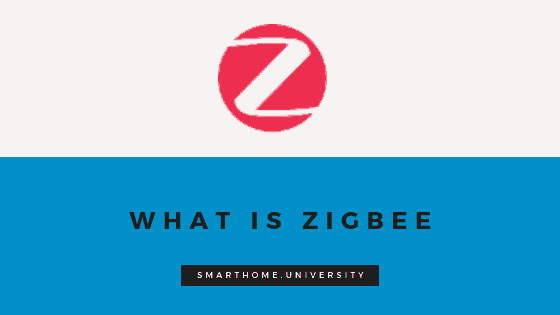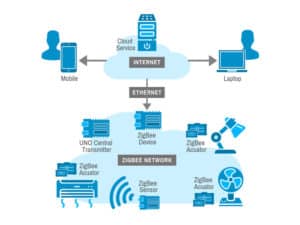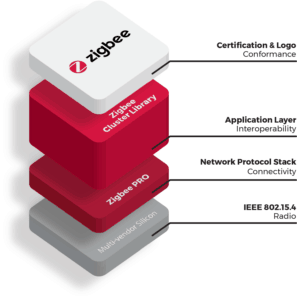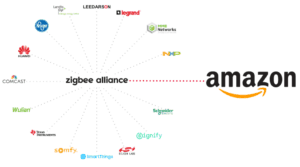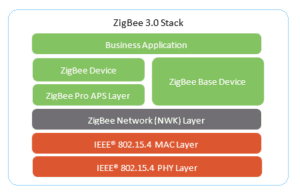Zigbee, open source smart home communication protocol made a huge progress in the last couple of year.
Choosing the right protocol is important when starting with your home automation, but many people still do not know what is Zigbee, its benefits and why to choose it over Bluetooth, RF, Wifi and arguably Z-wave protocols.
This article will help you to understand all the technical aspects as well as the average prices and major pros and cons.
Let’s dive in.
Contents
Why do you need this guide?
Internet of Things (IoT) and home automation products in general have a very fragmented landscape. Even a for a basic functions like connecting various devices there are at least five comparable protocols to choose from. Each have its pros and cons, but their main function is to sync smart home devices with each other using rich communications without using a lot of power.
Zigbee is one of those protocols and acts as a common language or a method of secured communication to ensure the interaction of the different techs from various manufacturers. However it is not easy to navigate through the complexities of how the protocol works.
We believe that Zigbee is a superior comms protocol for smart home devices due to lower cost of devices, low energy consumption, and interoperability. This definite guide aims to explain why we think this is the case.
Basics: What is Zigbee?
Zigbee is an open wireless communication global standard. It was primarily made to address the needs of low-power and low-cost wireless IoT networks.
The main focus of the protocol is home automation devices which are generally low bandwidth (heartbeat, status updates, sensor information) and low power.
- ZigBee is an open standard (compared to Z-wave which is a proprietary protocol). This has its benefits and disadvantages. Producers do not need to pay licensing fees to use Zigbee (is is also using license-free 2.4GHz band). At the same time, many devices are labelled as ZigBee but aren’t necessarily compatible – or, at least, they aren’t easy to interface with each other. To address this, the ZigBee Alliance promotes its voluntary certification program. Many companies making ZigBee-based products include heavy-hitters like Amazon, Comcast, IKEA, Schneider Electric, Signify (formerly Philips Lighting), and Samsung SmartThings.
- Zigbee also require a Zigbee gateway, in other words, this means that a central controller is needed for all the Zigbee devices to work.
What are benefits of Zigbee?
- Mesh network structure – even one product fails to work; others can continue to communicate without an issue
- Low power consumption – it uses only 50 milliJoules (0.05 Watt-seconds) per data transmission
- Lower cost of products as it is an open source protocol
- Can supports a large network – up to 65,000 in a single network
- Many devices to choose from – 2,500 products certified and 300 million products deployed
- Allows fast communication of data and less inference unlike RF and Bluetooth
- Devices are controlled in a local network, so no internet required
Zigbee Drawbacks
- Protocol fragmentation – many versions available; each producer incorporates Zigbee in its devices in a slightly differently
- Low data transmission rate compared to Z-wave, but it should not be an issue for the average homeowner
- Not as secure as Wi-Fi (Zigbee 3.0 fixed that)
- MIght not be as great for outdoor wireless communication due to short range and limited coverage
Average prices for ZigBee Devices:
The pricing for Zigbee devices depend on many factors including the brand, power supply, waterproofing and so on. Below is the average prices across the main categories of the devices for you to understand how much it would be to equip your home with Zigbee devices.
Zigbee Controllers
Controllers are important to connect all devices and control them. There are a number of zigbee controllers you can choose from:
- Smartthing hub ($193.80) – is one of the best hub to start using Zigbee devices. It can also connect to Zwave protocol
- ’Hubitat (Price not available) – is an alternative to SmartThings. Do not have as good UI, but a bit more capable hardware.
- ’HUSBZB-1 ($38.86) – is for the DIY smart home enthusiasts. It would work if you already have a server or Raspberry Pi
Zigbee Lights
- Sengled Smart LED Soft White A19 Bulb ($17.97) – is one of the best white bulbs to use. This is mainly due to the price, brand and ease of use
- ’Philips (Price not available)- is the next line option with much nicer transition and dimming capability. Hue became a household name for smart bulbs as well.
- ’Sylvania ($39.99) – is a perfect choice if you want to brighten your lightning with color.
Sensors
- Samsung SmartThings Motion Sensor ($39.99) – the best option for Zigbee sensors. Period. Consistent, lasts for ages and accurate
- ’NYCE (Price not available) – this is an alternative to SmartThings ecosystem
Zigbee History and Current Development
As you now understand the highlight of the Zigbee protocol it is worth exploring a bit of history, architecture and recent developments of the standards that we are excited about. Understanding this will help you understand that strategically Zigbee is a protocol of the future and it makes a case to be selected over the comparable solution.
Zigbee history
The idea of Zigbee-style networks came into being in 1998 when engineers started to realize that Bluetooth, as well as Wi-Fi, were unsuitable for various applications. To be more specific, engineers saw a dire need for self-organizing ad-hoc digital networks.
Zigbee got its name in quite a peculiar way. When bees are on their way back to the hive, they do something called a wiggle dance to communicate crucial information to other bees like where the new nest is or where to find high-quality pollen. This zigzag dance is the basis for Zigbee’s name.
In terms of layers, the Zigbee stack has four major layers. These are:
Zigbee architecture
Zigbee is an open wireless communication standard that’s based on the standard network architecture. It uses an OSI model via an IEEE 802.15.4-2006 IP layer.
The system structure has three different kinds of devices; Zigbee coordinate, router, and the end device. Every Zigbee network must have at least one coordinator since it acts as the network’s root and bridge. The coordinator handles and stores the information while also taking part in the transmitting and receiving data operation.
On the other hand, the routers function as intermediary devices that allow data to pass through them to other devices. Moreover, end devices only have limited functionality to communicate with the parent nodes which helps to save battery power. The exact number of coordinators, routers, and end devices depends on the network type such as mesh, tree, and star networks.
- Application layer:
This defines the various addressing objects like profiles, endpoints, and clusters.
- Network layer:
This adds the routing capabilities to the stack which allows RF data packets to traverse numerous devices to route the data from the source to the destination.
- MAC layer:
This manages RF data transactions from point to point. The MAC layer includes services like collision avoidance techniques and transmission retry & acknowledgment management.
- Physical layer:
This layer defines the way the devices are connected to form a network. It outlines the output power, transmission rate, and the number of channels.
What is Zigbee alliance?
Zigbee makers started an alliance back in 2002 involving the companies that sign up to use Zigbee. The alliance has over 400 members that have contributed more than 2500 devices between them. Members include committees, special interest groups, task forces, and study and work groups. AT&T, Philips, Logitech, and Belkin all support Zigbee. In particular, IoT devices have gained a lot more potential when using Zigbee.
The primary purpose of the Zigbee alliance is to simplify wireless product integration thus helping out manufacturers to incorporate energy-efficient wireless control in their products in a more cost-effective and faster way.
With the help of an open standards development process as the guide, the members create such standards that offer easy-to-use, low-power, secure, and reliable wireless communication. The profiles that the alliance publishes help vendors to make compatible products.
In the alliance, there are three kinds of memberships, each with different benefits and rights.
- An adopter provides access to the final and approved specifications, development activities, and standard task/work group documents. The adopter also offers participation in different interoperability events.
- A participant offers voting rights in work groups. The participant also gets early access to all alliance specifications and standards that are in development.
- Finally, the promoter provides automatic voting rights in all the work groups, a seat on the Zigbee alliance’s board of directors, and final approval rights on all the standards.
What is a current version of Zigbee?
Zigbee specifications were approved back in 2004 on 14th December which was termed as the Zigbee 2004 Specification. Once these were approved, on 13th June 2005, the public availability of the specification was announced.
In September 2006, the Zigbee 2006 Specification was introduced with the member availability version. Once the developments were made, at the end of 2007, Zigbee PRO, which is the final version was announced. The Zigbee PRO contains the enhanced Zigbee specification.
These Zigbee specifications boost the IEEE standard by adding security layers and networks along with an application framework. The standards agreed upon by the alliance are then used to manufacture multi-vendor interoperable products.
Although it might not be important for common users, Zigbee has a number of specifications which is worth explaining.
Zigbee PRO provides the basis for IoT and introduces features that support highly reliable, low-cost networks for device-to-device communication. In addition, it offers a new feature names Green Power which supports self-powered or energy harvesting devices that don’t need an AC power supply or even batteries to function.
Zigbee RF4CE
The Zigbee RF4CE is made for such simple, two-way device-to-device control applications that don’t require the full-featured mesh networking functionalities that Zigbee offers.
Zigbee IP
This specification optimizes the IPv6-based full wireless mesh networks standard. It offers internet connections for controlling low-cost and low-power devices.
What is Dotdot in Zigbee specification?
Quite recently, the alliance introduced “dotdot.” This is a program that extends the interoperability technology even beyond Zigbee. It is a universal language for IoT and allows smart objects to work together on a network. The introduction of dotdot has unlocked new, greater possibilities and has the power to unify the fragmented Internet of Things.
What is Zigbee 3.0?
The Zigbee 3.0 is very important step in Zigbee development. This is a very ambitious bet from the Zigbee community to build up a truly universal protocol across purposes which strengthen the existing Zigbee architecture and resolving many existing issues.
In brief, Zigbee 3.0 it is built on the existing Zigbee standard; however, it has a number of unique feature:
- Unifies the market-specific application profiles. As a result, it allows devices in the same network to be connected wirelessly regardless of their market function and designation.
- It is dull-stack, interoperable, and low-power certifiable Zigbee solution built on Zigbee PRO that enhances the IEEE standard by adding security layers and mesh network.
- Made with developers in mind and It increases both flexibility and choice for developers as well as users and offers the confidence that services and products will work together thanks to the standardization at all stack layers.
Pros of Zigbee 3.0
Given its flexibility, one can expect several pros of the Zigbee 3.0. Some are:
- Interoperability – The Zigbee 3.0 certification ensures device-to-device interoperability. Just one application language works for multi-vendor ecosystems which was a major drawback compared to Zwave. In addition, Zigbee 3.0 is designed for both backward and forward compatibility. (i.e. works under Zigbee Light Link 1.0 and Home Automation 1.2 )
- One solution for all – a single solution for various market niches ranging from home, building, and industrial to retail, health, and more as it includes an application layer for full implementations.
- Easy, reliable, and robust – All essential documents are present in one location, and there’s an easy-to-spot certification mark on all the certified products. Plus, multiple options for stack, module, and chip vendors mean that you’re not dependent on just one supplier.
- Global – Zigbee’s 2.4 GHz ISM band ensures the deployment of license-free product worldwide.
- Over-The-Air upgrade feature for the software updates while the device is operating means that applications on the devices that have already been deployed in the field can be migrated to Zigbee 3.0 easily and seamlessly, regardless of where they are deployed.
Cons of Zigbee 3.0
Primarily because of the mesh network, Zigbee 3.0 doesn’t come with too many drawbacks.
Zigbee 3.0 unifies various application layer protocols on device networking, discovery, and joining, making the networking simple and easy. The problem is, it doesn’t include the Smart Energy application layer protocol. This means that Zigbee products with the Smart Energy application cannot interact with Zigbee 3.0 devices.
Zigbee vs Z-wave vs Wi-fi, vs Bluetooth vs RF
It is true that other protocols like Wi-Fi, Bluetooth, and RF also allow devices to communicate with each other. The question is; why should one opt for Zigbee instead of, let’s say, RF?
Let’s learn why Zigbee is preferred more over the other protocols.
Zigbee vs. Z-wave
We looked into the details of the Zigbee vs. Z-wave in our detailed overview here, but our preference is still with Z-wave due to
Zigbee vs. Wi-Fi
Wi-Fi uses quite a lot of power which is a drawback for battery-powered devices as well as for devices in which low power consumption is essential like a light bulb. Moreover, having several devices on one home network isn’t a great idea in terms of stability and performance. Plus, Wi-Fi range can also be an issue in large homes.
On the other hand, Zigbee uses less power as compared to Wi-Fi. In addition, it is designed such that it can support even hundreds of devices on one network via. However, the most important fact is that Zigbee has a different network type called mesh network. In this network, the device doesn’t have a direct connection with the hub. Instead, each Zigbee device can connect via another Zigbee device with that device conveying data packets between the two.
Zigbee vs. RF
The frequency of RF lies within the range of 10 kilohertz to up to 300,000 megahertz. On the other hand, Zigbee is an IEEE 802.15 standards-based wireless technology that is primarily used to connect low-power devices in a network.
So, compared to RF modules, Zigbee offers a long range of communication. Another difference is the power consumption; Zigbee’s power consumption is quite low.
Zigbee vs. BLE
BLE or Bluetooth Low Energy is a PAN (personal area network) which means that its range is much shorter than that of Zigbee. So, BLE can only connect to devices that are near the user.
While BLE’s range is shorter, the data rate is much higher. BLE’s data rate is 1 Mbit/s for short bursts, and it sleeps between the bursts; thus it requires lower power usage and date. Zigbee doesn’t have this functionality. In addition, BLE is supported by various operating systems including OS X, Android, Windows 8/10, and iOS; all spaces that Zigbee hasn’t yet branched into.
Who should not choose Zigbee?
We will be honest with you, we struggled to agree the reasons why would you not use Zigbee. It has a number of advantages over non IoT specific protocols like Wifi, bluetooth and RF. Compared to Z-wave it is cheaper, more consistent regionally and Zigbee 3.0 gave a massive push for future development.
Zigbee allows broad-based deployment of wireless networks with low-power, low-cost solutions. As we mentioned before, it is ideal for an average home user due to low price, good pace of development and low power consumption. You can now find Zigbee devices that are in almost any area that need IoT solution, including:
- Smart grid/smart energy
- Fleet applications
- Medical devices
- HVAC control
- Tank monitoring
- Building automation systems
- Lighting controls
- Automatic meter reading
Moreover, Zigbee devices are known to excel in commercial applications primarily because of its capabilities on IoT. Zigbee’s design is such that it lends itself to monitoring and sensing applications. In fact, its use in large-scale wireless monitoring is rapidly growing.
Who should choose Zigbee?
- Zigbee is ideal for homeowners and renters as it allows you to smarten almost any electrical device in your house.
- It also great as the main protocol for smart sensors for motion detection, temperature and luminance and so on
- With Zigbee, consumers have a chance to take ownership of their consumption. For example, using smart products that allow the control power as well as water consumption can help save quite a good amount of money!
- Similarly, utility companies can make use of Zigbee in smart meters to control, inform, automate, and monitor both water and energy consumption. These smart meters can then give consumers the information they need to cut down energy wastage and in turn save money.
- Zigbee-based products can enhance the shopping experience by enabling in-store assistance and item location and faster checkouts, making it a solution for retailers to invest in. In fact, Zigbee can help retailers increase their efficiency by making sure that items don’t run out of stock and by supporting just-in-time inventory practices. Similarly, Zigbee products can monitor spills and humidity, making such products the ideal shopping assistance.
Who should not choose Zigbee?
- As mentioned earlier, Zigbee is suitable if the distance between your devices isn’t too much and if you have a lot of devices. However, it is best not to choose Zigbee if you have just a few devices that are far apart from each other.
- Moreover, Zigbee currently supports Hive Active Heating products, Belkin, Amazon Echo Plus, WeMo Link, and Philips Hue. So, if your home is fitted with smart home devices other than these, then Zigbee is not for you.
Common Questions about Zigbee
Perhaps the most common question about Zigbee is what is Zigbee technology. However, that has already been discussed in quite a lot of detail above. Of course, you might still have several questions in mind. We’ve tried our best to answer the most common questions about Zigbee here:
Does Zigbee support Mesh?
A mesh network is basically when a network connection spreads out among the wireless nodes allowing them to communicate with one another and share a connection across a big area. Nodes can be understood as small transmitters that function just like a wireless router does. Zigbee can support up to 65,000 nodes on just one network.
Does Zigbee work with Google Home?
The Google Home hub doesn’t support Zigbee which means you can’t use it to set up a smart home.
Does Zigbee work with Alexa?
The new Echo Plus and Echo Show have a Zigbee hub built-in which allows Zigbee to work with Alexa.
Does Zigbee work with SmartThings?
Samsung’s SmartThings devices contain Zigbee chips which means they can work with Zigbee and can send and receive information. This is true for both SmartThing Hub version 2 and SmartThings Version 3
Is SmartThings ZigBee or Z Wave?
Samsung’s SmartThings hub contains both Z-wave and Zigbee radio antennae to communicate with Zigbee and Z-wave devices wirelessly. The hub functions as a primary controlled for Zigbee and Z-wave networks.
Can Google Home control ZigBee devices?
Since the Google Home hub doesn’t have a Z-wave or Zigbee radio, it can’t control Zigbee devices.
Can Alexa control Zigbee devices?
It is possible to connect the Zigbee-based smart devices to Alexa and let it control Zigbee-based devices via the built-in hubs in the new Echo Plus and Echo Show. Moreover, Alexa can also control Zigbee devices via other Zigbee-certified hubs like those from Wink and SmartThings.
Can Z-Wave and ZigBee communicate with each other?
Zigbee and Z-wave both create a mesh network between the various devices present in your house. However, the two technologies can’t communicate with each other. Z-wave can only form a network with other Z-wave devices, and the same is the case with Zigbee.
Last update on 2024-04-27 / Affiliate links / Images from Amazon Product Advertising API
